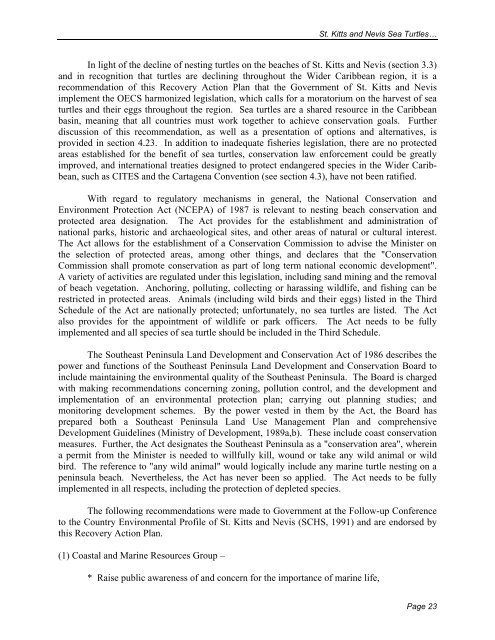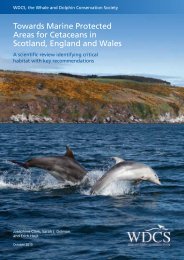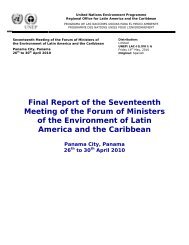Sea Turtle Recovery Action Plan for St. Kitts and Nevis - WIDECAST
Sea Turtle Recovery Action Plan for St. Kitts and Nevis - WIDECAST
Sea Turtle Recovery Action Plan for St. Kitts and Nevis - WIDECAST
Create successful ePaper yourself
Turn your PDF publications into a flip-book with our unique Google optimized e-Paper software.
<strong>St</strong>. <strong>Kitts</strong> <strong>and</strong> <strong>Nevis</strong> <strong>Sea</strong> <strong>Turtle</strong>s…In light of the decline of nesting turtles on the beaches of <strong>St</strong>. <strong>Kitts</strong> <strong>and</strong> <strong>Nevis</strong> (section 3.3)<strong>and</strong> in recognition that turtles are declining throughout the Wider Caribbean region, it is arecommendation of this <strong>Recovery</strong> <strong>Action</strong> <strong>Plan</strong> that the Government of <strong>St</strong>. <strong>Kitts</strong> <strong>and</strong> <strong>Nevis</strong>implement the OECS harmonized legislation, which calls <strong>for</strong> a moratorium on the harvest of seaturtles <strong>and</strong> their eggs throughout the region. <strong>Sea</strong> turtles are a shared resource in the Caribbeanbasin, meaning that all countries must work together to achieve conservation goals. Furtherdiscussion of this recommendation, as well as a presentation of options <strong>and</strong> alternatives, isprovided in section 4.23. In addition to inadequate fisheries legislation, there are no protectedareas established <strong>for</strong> the benefit of sea turtles, conservation law en<strong>for</strong>cement could be greatlyimproved, <strong>and</strong> international treaties designed to protect endangered species in the Wider Caribbean,such as CITES <strong>and</strong> the Cartagena Convention (see section 4.3), have not been ratified.With regard to regulatory mechanisms in general, the National Conservation <strong>and</strong>Environment Protection Act (NCEPA) of 1987 is relevant to nesting beach conservation <strong>and</strong>protected area designation. The Act provides <strong>for</strong> the establishment <strong>and</strong> administration ofnational parks, historic <strong>and</strong> archaeological sites, <strong>and</strong> other areas of natural or cultural interest.The Act allows <strong>for</strong> the establishment of a Conservation Commission to advise the Minister onthe selection of protected areas, among other things, <strong>and</strong> declares that the "ConservationCommission shall promote conservation as part of long term national economic development".A variety of activities are regulated under this legislation, including s<strong>and</strong> mining <strong>and</strong> the removalof beach vegetation. Anchoring, polluting, collecting or harassing wildlife, <strong>and</strong> fishing can berestricted in protected areas. Animals (including wild birds <strong>and</strong> their eggs) listed in the ThirdSchedule of the Act are nationally protected; un<strong>for</strong>tunately, no sea turtles are listed. The Actalso provides <strong>for</strong> the appointment of wildlife or park officers. The Act needs to be fullyimplemented <strong>and</strong> all species of sea turtle should be included in the Third Schedule.The Southeast Peninsula L<strong>and</strong> Development <strong>and</strong> Conservation Act of 1986 describes thepower <strong>and</strong> functions of the Southeast Peninsula L<strong>and</strong> Development <strong>and</strong> Conservation Board toinclude maintaining the environmental quality of the Southeast Peninsula. The Board is chargedwith making recommendations concerning zoning, pollution control, <strong>and</strong> the development <strong>and</strong>implementation of an environmental protection plan; carrying out planning studies; <strong>and</strong>monitoring development schemes. By the power vested in them by the Act, the Board hasprepared both a Southeast Peninsula L<strong>and</strong> Use Management <strong>Plan</strong> <strong>and</strong> comprehensiveDevelopment Guidelines (Ministry of Development, 1989a,b). These include coast conservationmeasures. Further, the Act designates the Southeast Peninsula as a "conservation area", whereina permit from the Minister is needed to willfully kill, wound or take any wild animal or wildbird. The reference to "any wild animal" would logically include any marine turtle nesting on apeninsula beach. Nevertheless, the Act has never been so applied. The Act needs to be fullyimplemented in all respects, including the protection of depleted species.The following recommendations were made to Government at the Follow-up Conferenceto the Country Environmental Profile of <strong>St</strong>. <strong>Kitts</strong> <strong>and</strong> <strong>Nevis</strong> (SCHS, 1991) <strong>and</strong> are endorsed bythis <strong>Recovery</strong> <strong>Action</strong> <strong>Plan</strong>.(1) Coastal <strong>and</strong> Marine Resources Group –* Raise public awareness of <strong>and</strong> concern <strong>for</strong> the importance of marine life,Page 23

















